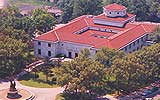Faculty
Kathleen Wren Christian
After Pope Martin V brought the papacy back to Rome in 1420, the city rebuilt itself out of its own ruins. The papacy’s return brought an economic boom, and families with new wealth gained instant social caché by inventing ancient ancestors, using collections of antique statuary to forge imaginary bloodlines to past heroes. Call it early branding. In her forthcoming book, tentatively titled The Art of Place: Collections of Ancient Sculpture in Renaissance Rome, Christian explores how ancient marble sculpture - which had formerly been used as building material - took on new life in Renaissance Rome.
Collecting ancient sculpture, Christian argues, was also closely tied to the idea of “exemplarity.” To own a collection of antique objects was to possess a wide range of “examples” of virtue and vice. Possessing and meditating on lessons from the past helped collectors construct inner treasure-troves of wisdom.
By the end of the fifteenth century, a garden collection of antiquities became a necessity for all wealthy Romans. These were often the settings for sumptuous banquets featuring pagan-themed poetry and music. “The sculpture garden was presented as a realm of the Muses,” says Christian, “and in this way it became the common focus of poets and artists.”
“In the Renaissance, antique images played an essential role in contemporary visual culture,” says Christian. “With new attitudes towards antique sculpture we can trace the birth of the ‘work of art’ and also the art market as we know it.”
Patrons didn’t let just anybody view their collections, but often presented them as “gifts” to their guests, in what might be viewed as a precursor to today’s museum donations. As visual artists claimed an increasingly important role in Rome’s intellectual élite, they also started to collect themselves. By the early 16th century, Raphael designed “a palace suitable for a Roman aristocrat,” Christian says, complete with space in the courtyard for the display of ancient sculpture.
